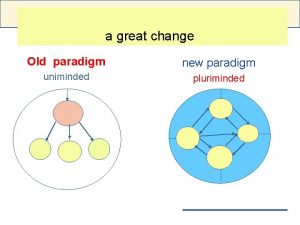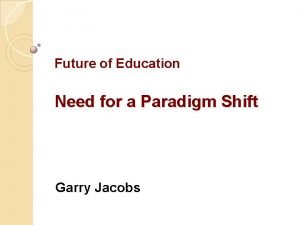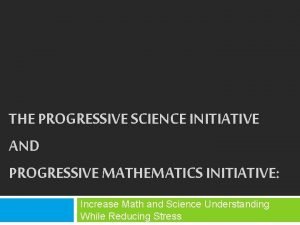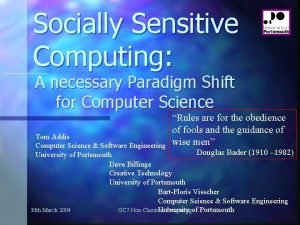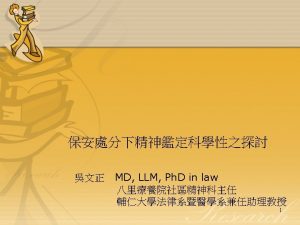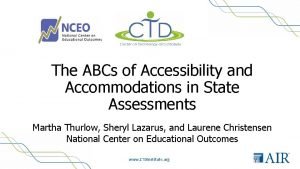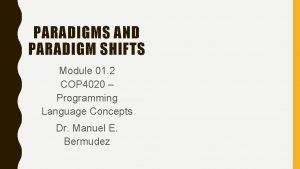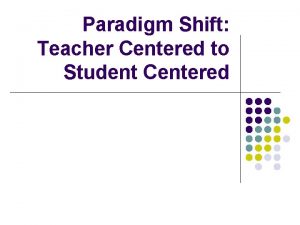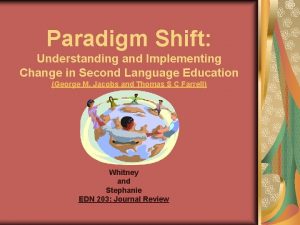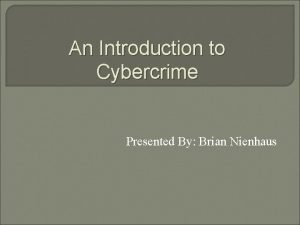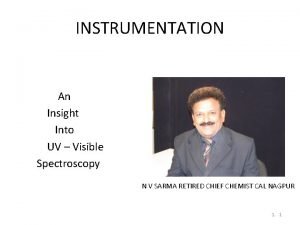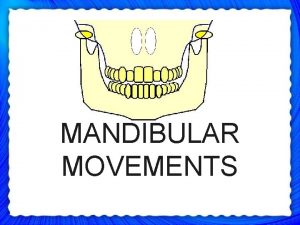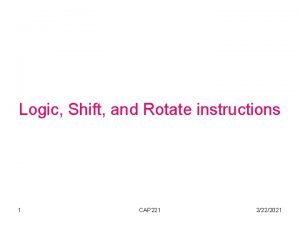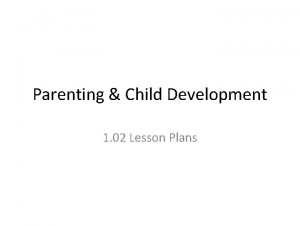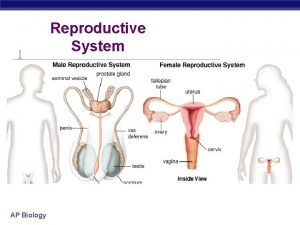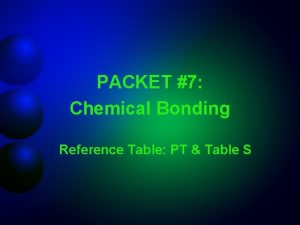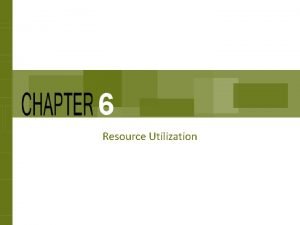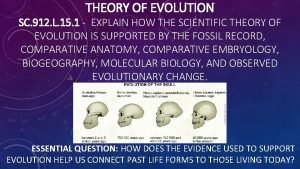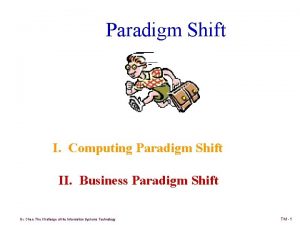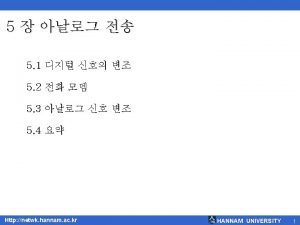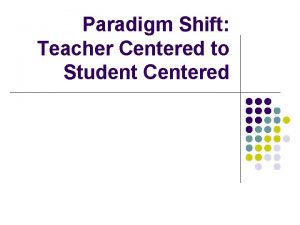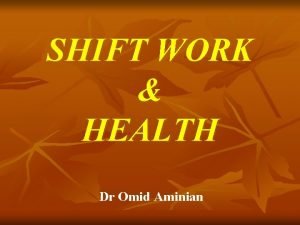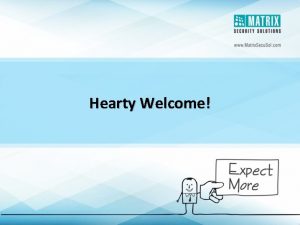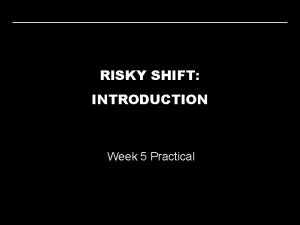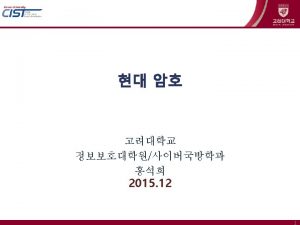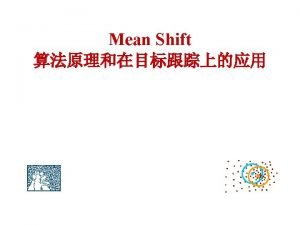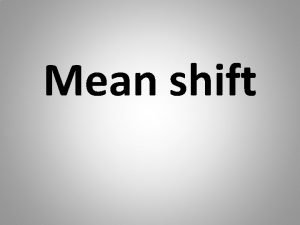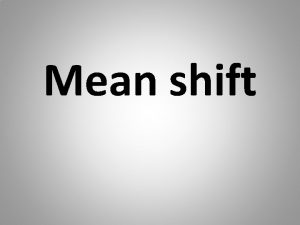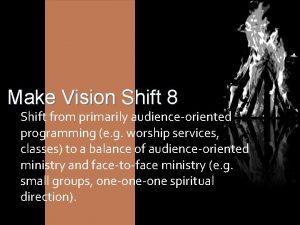This story illustrates a paradigm shift A paradigm


































- Slides: 34




This story illustrates a paradigm shift. A paradigm shift is a new way of looking at a situation and/or problem that is completely different from the way you viewed it in the past. How are we experiencing a major paradigm shift in health today?

In the 1800 s and early 1900 s infectious (communicable) diseases such as influenza, tuberculosis, and diphtheria were the leading causes of death. In the 20 th century these have been replaced with the chronic (lifestyle) diseases; accidents, suicide, heart disease, cancer (malignant neoplasms), and stroke.

When infectious diseases were the leading causes of death, health care was more of a mechanistic model. Mechanistic means that you basically live your life until something breaks down and then go see a doctor and get it fixed.

Now that the leading causes of death are lifestyle diseases, a preventative model is more critical. suggests that health is a culmination of your lifestyle choices.

Soooooo… What do you think is the leading cause of death among teenagers?

#1 Motor Vehicle Accidents From 2006 -2010, about 18, 000 teens in the United States aged 16– 19 were killed and more than 350, 000 were treated in emergency departments for injuries suffered in motor-vehicle crashes. 1, 2 Teens represent less than 10 % of the U. S. population. However, they account for nearly three times as many accidents as people aged 20 and older. 3

Cause of Death While unintentional injury is listed as the #1 cause of death with 7137 deaths, of those deaths 5522 are from motor vehicle accidents so we consider motor vehicle accidents as the #1 cause of death among 15 – 19 yr. olds. Unintentional Injury * Motor Vehicle Traffic * Poisoning * Drowning * Firearm * Other Land Transport * Fire/burn * Fall * Unspecified * Other Transport * Pedestrian, Other * Suffocation No of Deaths Percent 7137 5522 486 320 107 100 86 83 79 69 68 68 51. 67% 39. 98% 3. 52% 2. 32% 0. 77% 0. 72% 0. 60% 0. 57% 0. 50% 0. 49% * Other Spec. , classifiable 56 0. 41% * Natural/ Environment * Struck by or Against * Machinery * Other Spec. , NEC * Pedal cyclist, Other * Cut/pierce 30 30 11 11 7 4 0. 22% 0. 08% 0. 05% 0. 03%

# 2 Homicide Although other teens are responsible for many of the homicides of teens below age 18, twothirds of the murderers are eighteen or older. 4 Gang involvement has been associated with many teen murders; in 2002, nearly threequarters of homicides of teens were attributed to gang violence. 5 Although school-related homicides receive substantial attention, they account for less than 2% of all children homicides.

#3 Suicide Teen suicide results in approximately 4600 lives lost each year. The top three methods used in suicides of young people include firearm (45%), suffocation (40%), and poisoning (8%).

#4 Malignant Neoplasms (cancer) Malignant neoplasm implies a lesion that can invade and destroy the adjacent tissues and spread to the distant sites(Metastasize) and cause death, Malignant tumor are also called CANCER

#5 Heart Disease Most of the risk factors that affect children can be controlled early in life, lowering the risk of heart disease later in life. Other risk factors are usually passed down through family members (they are hereditary) or they are the result of another illness or disease. These risk factors usually can be controlled. Congenital heart disease (heart defects you are born with) cannot be changed, but better tests and treatments are now available for children with these types of heart problems.


6 Components of Health Do you know what they are?


Emotional Health

Emotional Health Expressing emotions in a positive, nondestructive way. Being able to cope with unpleasant emotions and not get overwhelmed by them

s e v l e s r u o t u Do we have p o e t w s n o o i D t i s o control ? in p t r u h get over our emotions? ? Do o thers have an e f f e ct on our e moti ons?

Social Health

Social Health ~ Quality of your relationships with others ~ Respecting others ~ Avoid others who don’t treat you with respect and tolerance

Mental Health

Mental Health : The ability to recognize reality and cope with demands of daily life. : Having a high self-esteem about yourself. : Your mental health can be strongly influenced by your emotional health.

Who is most effected by mental health problems? How serious do we take our mental health?

Spiritual Health

Spiritual Health Maintaining harmonious relationships with others Having directions and purpose in your life Living according to one’s ethics, moral & values. For some it means religion, for others it is understanding their purpose in life

What are things we can do to make us better people? Who ultimately controls your Destiny? Can you make a change in someone else's life?

Environmental Health

Environmental Health Made up of living and non living things Includes air, water and land Keeping your “environment” enjoyable and safe. Recycling Cutting down on pollution

Physical Health

Physical Health Refers to body functions Eating right Exercise Being at recommended weight Avoiding drugs & alcohol Being free of disease & sickness

h c a e s e o f d o w t Ho ponen com health r? e h t our o h c a e t c e eff Is ther e one produ can m c t t h a a k e t u in eve s heal ry are thy a of ou r life?

WHEEL Activity: How would you rate your physical, emotional, social, environmental, mental & spiritual health? What are some things you can do to give yourself a better wheel?
 Old paradigm meaning
Old paradigm meaning Paradigm shift in education
Paradigm shift in education Paradigm shift in technology
Paradigm shift in technology Paradigm shift meaning
Paradigm shift meaning Paradigm shift from women studies to gender studies
Paradigm shift from women studies to gender studies Paradigm shift kuhn
Paradigm shift kuhn Paradigm shift in technology
Paradigm shift in technology Definition of paradigm
Definition of paradigm Paradigm shift from pedagogy to andragogy to heutagogy ppt
Paradigm shift from pedagogy to andragogy to heutagogy ppt Stock image
Stock image Paradigm shift in education
Paradigm shift in education Crime tree
Crime tree Paradigm shift in technology
Paradigm shift in technology Difference between arithmetic shift and logical shift
Difference between arithmetic shift and logical shift Bathochromic shift and hypsochromic shift
Bathochromic shift and hypsochromic shift Difference between arithmetic shift and logical shift
Difference between arithmetic shift and logical shift Difference between arithmetic shift and logical shift
Difference between arithmetic shift and logical shift Mandibular movement
Mandibular movement Homocyclic diene component
Homocyclic diene component Difference between arithmetic shift and logical shift
Difference between arithmetic shift and logical shift Cap 221
Cap 221 Molecular absorption
Molecular absorption A contour drawing illustrates
A contour drawing illustrates A completely submerged object always displaces its own
A completely submerged object always displaces its own Production possibilities curve illustrates
Production possibilities curve illustrates Application on exterior angle inequality theorem
Application on exterior angle inequality theorem Which illustrates an emotional aspect of teen sexuality?
Which illustrates an emotional aspect of teen sexuality? Draw the diagram of pyramid of number grass goat human
Draw the diagram of pyramid of number grass goat human The associative law for addition is normally written as
The associative law for addition is normally written as A bar magnet that holds a chain of paper clips illustrates
A bar magnet that holds a chain of paper clips illustrates What is the height of each of the 14 steps?
What is the height of each of the 14 steps? Uterus images real
Uterus images real Which diagram best illustrates the ion molecule attractions
Which diagram best illustrates the ion molecule attractions The resource requirements plan illustrates
The resource requirements plan illustrates The diagram illustrates an embryonic stage of two organisms
The diagram illustrates an embryonic stage of two organisms
